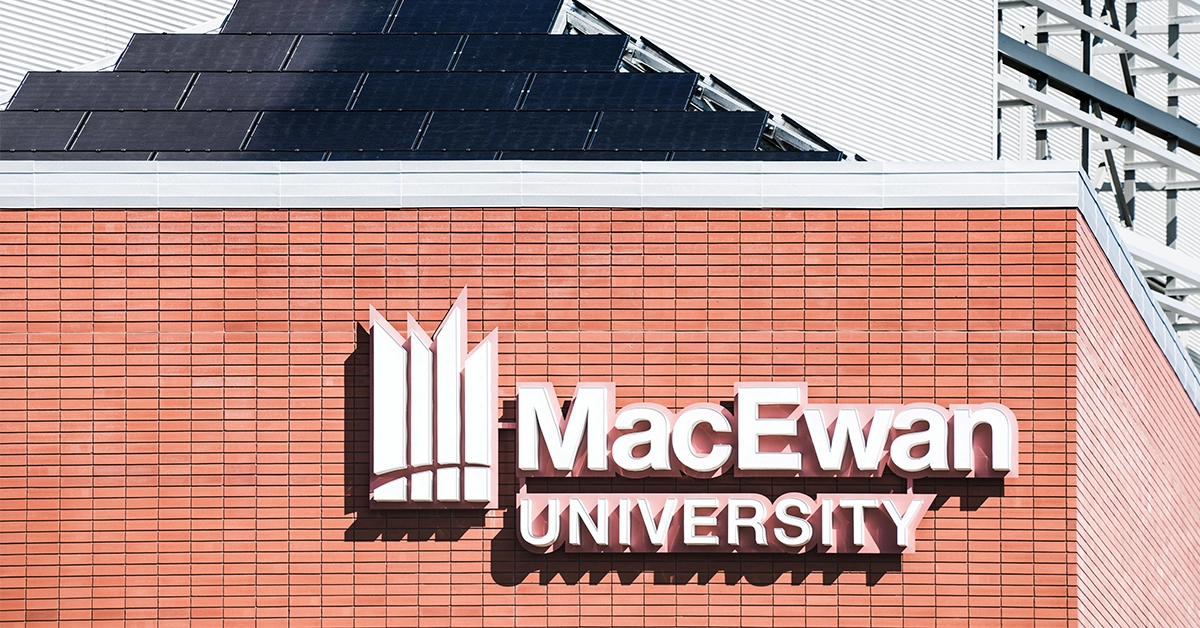As corporations, institutions, and individuals head toward “going green,” the use of solar panels has become one of the more popular options for reducing ecological impact. MacEwan University’s Office of Sustainability helps to chart the university’s course in environmentally conscious initiatives and, along with the university’s facilities department, has commenced a solar energy pilot project on campus.
“MacEwan Facilities is in the completion stages of a photovoltaic solar energy supply project, located on a (third) level, south-facing roof of the Robbins Health Learning Centre,” says a statement from the facilities department. “The new photovoltaic system is comprised of 50 solar panels, with 30 panels facing south and 20 panels facing west, installed on a sloped galvanized steel frame to optimize the exposure to the seasonal angle of the sun.”
“Panels are manufactured by Trina, a top global producer of solar panels, and have evolved in technology and effectiveness over the past 20 years. Each panel is rated at 280 watts and (they are) collectively estimated to generate 16,000 kWh annually. An annual generation of 16,000 kWh is equivalent to the electrical energy used to operate (two) average Alberta homes for a year.”
More equipment is required than just the panels in order for the solar energy system to function, says facilities. Energy from the panels must go through an inverter, located inside the building, in order to convert the direct current to a usable alternating current.
According to the department, “The inverter supplies an electrical sub-panel which distributes the energy to the existing ventilation equipment loads located in the mechanical room and servicing the Robbins Health Learning Centre.”
Facilities says that, with the new installation, annual savings in electricity costs to the university are estimated at about $1,500.
“The installation is considered a pilot project and will be monitored for effectiveness with an intention of expanding the use of alternative energy generation on campus and reducing the reliance on carbon emitting electrical generation,”
facilities says.
“During the Strategic Campus Sustainability Plan (SCSP) update, staff, students, faculty, and the community identified reducing our energy consumption and implementation of renewable energy as key areas of sustainability action on campus,” says Kalen Pilkington, MacEwan’s sustainability coordinator.
The SCSP covers all areas of university life, she says, and helps the Office of Sustainability to move forward with initiatives in a way that aligns with campus interests.
“This is just one piece to a larger sustainability picture on campus,” says Pilkington.
The goal of the Campus Operations section of the Strategic Campus Sustainability Plan is “to create a model sustainable campus that fosters well-being for individuals, communities, and ecosystems,” she says. One of the ways it aims to do this, according to the plan, is by designing and renovating buildings in a way that ensures they produce less greenhouse gas.
“The use of solar energy helps to offset the amount of electricity imported from the grid. (Alberta) is one of the few provinces still very dependent on fossil fuels and coal,” says Jenny Hong, senior project manager for City Environmental Strategies with the City of Edmonton.
She says that changing to solar energy would be a relatively easy process for Edmonton because it gets a lot of sunlight throughout the course of a year. According to Hong, solar panels in Edmonton have the potential to generate the same amount of energy as their counterparts in Rio De Janeiro.
The benefits of solar energy are vast. Some of the more prominent points Pilkington highlights include that it “is a cleaner source of energy than fossil fuels, is renewable, reduces (and sometimes eliminates) energy bills, helps to reduce greenhouse gas emissions, and provides energy reliably, especially in Alberta.”
Other advantages include increased energy security for MacEwan through diversification of power sources, as well as a valuable contribution to the creation of jobs in the renewable energy field.
The use of solar energy helps to demonstrate MacEwan’s commitment and responsibility to a low-carbon future, Pilkington adds.
Smaller solar panel systems can incur high expenses, which stops the technology from being a viable option for some homes and small businesses, says Hong. However, she says that every year the cost is being reduced, and she hopes that the use of solar energy will become more widespread. As educational institutions lead the way in sustainable technological development, MacEwan has a vested interest in exploring the possibilities of low ecological impact education.
“It is important that MacEwan University continually strive to be more responsible in a number of different areas, including energy efficiency,”
says Pilkington.
MacEwan Sustainability reports to the Sustainability Tracking, Assessment & Rating System (STARS), a program of the Association for the Advancement of Sustainability in Higher Education, says Pilkington.
“(STARS) is a transparent, self-reporting framework for colleges and universities to gauge relative progress towards sustainability. MacEwan is currently a silver-rated institution.”
Many community buildings, including elementary schools, high schools, and community leagues, are moving toward more sustainable energy practices, says Pilkington. MacEwan has been working on partnerships in solar energy with a growing number of post-secondary schools in Alberta and across Canada.
“(The use of solar energy) is getting more and more common. In 2010, the City had 105 kW of installed solar, which has since grown to 2,245 kW,” Hong says, quoting an EPCOR statistic.
“The City of Edmonton has a grant called EcoCity that a number of community leads … have used to subsidize solar panel projects in schools and community leagues. The City recently passed a new policy that for all new civic buildings, one per cent of total capital budget for the new building will be spent on onsite energy generation.”
For the city as a whole, however, MacEwan’s possible transition to solar energy would have only a miniscule effect.
“(The effect would be) likely very small … but it is always good for a public institution like Grant MacEwan to lead by example,” says Hong.
The solar pilot project has already engaged the attention of students, eliciting positive responses
“It has been really encouraging how many people have noticed the solar installation going up,”
says Pilkington.
Solar energy is being piloted on campus with the intention of moving forward with other renewable energy projects in the future, Pilkington says, with the overall goal being to reduce MacEwan’s environmental impact as much as possible.
“Working in academics, operations, engagement, and leadership, energy efficiency helps to contribute towards MacEwan University being a more responsible community member that is striving for environmental responsibility, social equity, cultural vitality, and economic integrity.”
Photography by Matthew Jacula.





0 Comments